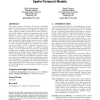61 search results - page 4 / 13 » A daily behavior enabled hidden Markov model for human behav... |
ISWC
2005
IEEE
13 years 11 months ago
2005
IEEE
Children with autism often exhibit self-stimulatory (or “stimming”) behaviors. We present an on-body sensing system for continuous recognition of stimming activity. By creatin...
CVIU
2006
13 years 6 months ago
2006
This paper presents a new approach to scene analysis, which aims at extracting structured information from a video sequence using directly low-level data. The method models the se...
ATAL
2006
Springer
13 years 9 months ago
2006
Springer
This paper presents a framework for robustly recognizing physical team behaviors by exploiting spatio-temporal patterns. Agent team behaviors in athletic and military domains typi...
CMOT
2010
13 years 3 months ago
2010
: In Wilderness Search and Rescue (WiSAR), the incident commander (IC) creates a probability distribution map of the likely location of the missing person. This map is important be...
ROMAN
2007
IEEE
14 years 10 days ago
2007
IEEE
—This paper proposes a novel method of learning a users preferred reward modalities for human-robot interaction through solving a cooperative training task. A learning algorithm ...

